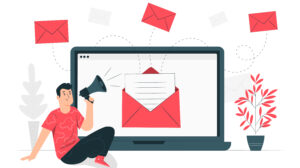Email marketing has long been an effective way for brands to connect to customers and boost sales, but that doesn’t mean that you’ve yet landed on a strategy that fully maximizes your email marketing potential.
Without paying attention to certain data points, you can’t know whether or not your emails are helping you hit your targets. Here, discover five key things to pay attention to in order to understand the effectiveness of your campaigns.
1. Open Rate
Your email open rate refers to the percent of people that received a given email who actually open it. While this percent can vary depending on the industry, you typically want to see between 20 and 40% of your subscribers opening an email.
Naturally, the more people who open an email, the more potential for sales you have for that campaign.
If your open rate is low, consider the following strategies:
- Use a professional business email address to ensure that your emails are recognized.
- Write subject lines that entice people to open your emails (give them a benefit to do so).
- Make sure everyone on your email list has subscribed and is interested in receiving your emails.
2. Click-Through Rate
Now we’ll move onto your click-through rate, which refers to the percent of people who click a link in your email. People may open your emails, but that doesn’t guarantee they’ll click a link to a product page or blog post once they open it. It’s your job to entice them with the content of your email so that they can’t help but click.
For low click-through rates, try:
- Ensuring your email is mobile-friendly so subscribers can easily click on a phone.
- Use just one call-to-action per email. More just confuses the reader.
- Segment your email lists and send content and offers tailored to each group.
3. Unsubscribe Rate
This is one metric to pay particular attention to because once it starts rising, you start losing potential customers. If your unsubscribe rate increases, it means that more people are opting out of your emails. Sure, a certain amount of shrinkage should be expected, but if numbers steadily decline, it’s time to try something new:
- Send fewer emails. Sometimes people get overwhelmed with the frequency and unsubscribe.
- Make each email matter. It should promote a single product, provide useful information about your brand, or give general updates and offers in a newsletter.
- Be consistent when you send your emails so people know what to expect.
4. Sales
The previous three data points are ones you can assess from within your email marketing software, but you may need to go to your sales platform or web analytics tool to measure this one. Ideally, you’re looking for a decent percent of the people who clicked a link in your newsletter to then make a purchase through that link.
Of course, the conversion rate depends on the type of email you’re sending. If, for example, you send a newsletter and have a link to a product, you may only see a 1% sales conversion rate. But if you send an email with a special offer to a shopper who abandoned her shopping cart before making a purchase, you may see a conversion rate closer to 5%.
No matter where your sales from emails are now, there’s always room for growth:
- Send a follow-up email after a purchase with a discount on a future offer.
- Check in with customers who haven’t bought from you in a while to boost sales.
- Test different offers to see which gets more conversions.
5. Signups
Before any of this happens, you need to attract new subscribers to your email marketing list. It will take time to grow the list (be patient!), but if you create a compelling offer and promote it across marketing channels, you’ll see your subscriber signups snowball.
The key is that compelling offer. People guard their email addresses these days since the average person gets dozens if not hundreds of messages from brands like yours, so there has to be an exceedingly good reason for them to give you theirs.
If you pay attention to marketing campaign data across all channels, you’ll likely know the kinds of offers that your audience responds positively to. That might be a buy one, get one free offer or a 25% off coupon. Make this the carrot you dangle to get email signups. In your in-store signage, as well as on other marketing channels like social media and your website, encourage shoppers to sign up for your emails to get that high-value, one-time offer. The fine print must inform them that signing up will then put them on your regular email list.
Here’s how to increase those email signups:
- Train store clerks to ask customers at checkout if they want to get on your list to save.
- Schedule an email signup popup box on your site to appear the first time a visitor arrives.
- Include a box to check if a new online shopper does not want to receive your emails.
Final Email Marketing Tips
In general, be mindful when sending customers emails. Put thought into the product you’re promoting (maybe you offer gift ideas for Father’s Day) or the content you share.
The more personalized you make the email, the better the results you’ll see. Rather than sending the same offer to your entire list, send several emails, each with a different offer or highlighted product.





